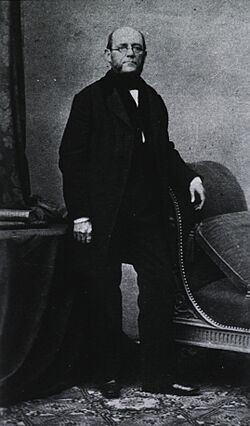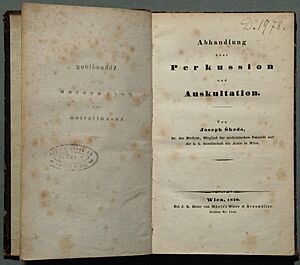Joseph Škoda facts for kids
Quick facts for kids
Joseph Škoda
|
|
|---|---|

Joseph Škoda
|
|
| Born | 10 December 1805 |
| Died | 13 June 1881 (aged 75) |
| Scientific career | |
| Fields | Internal medicine |
Joseph Škoda (born December 10, 1805 – died June 13, 1881) was an important Austrian doctor and medical professor. He was also a specialist in skin diseases. Along with Carl Freiherr von Rokitansky, he helped create the modern way of teaching medicine in Vienna.
Life and Career
Joseph Škoda was born in Pilsen, in what was then the Austrian Empire. He was the second son of a locksmith. He went to school in Pilsen and later studied at the University of Vienna, becoming a doctor in 1831.
He first worked as a doctor in Bohemia during a cholera outbreak. From 1832 to 1838, he was an assistant doctor at the Vienna General Hospital. In 1839, he became a city doctor for the poor in Vienna. In 1840, he was chosen to be the chief doctor for a new department at the hospital that focused on tuberculosis.
In 1846, Joseph Škoda became a professor at the medical clinic. This happened thanks to the strong support of Carl Freiherr von Rokitansky, a professor of pathological anatomy. In 1848, Škoda made a big change: he started giving his lectures in German instead of Latin. He was the first professor to do this.
He became an active member of the Austrian Academy of Sciences in 1848. In 1851, he treated Petar II Petrovic Njegos, who was suffering from tuberculosis.
Joseph Škoda retired from his teaching job in 1871. Students and people in Vienna celebrated him with a large torchlight procession. He passed away in Vienna. Rokitansky described him as "a light for those who study, a model for those who strive, and a rock for those who despair." Škoda was known for being kind and generous. Even though he earned a lot of money and lived simply, he left most of his wealth to help various charities.
Joseph Škoda was the uncle of the famous industrialist Emil Škoda.
Medical Contributions
Joseph Škoda made huge contributions to medicine by improving how doctors examine patients. He focused on methods of physical investigation to help with diagnosis.
One important method he used was percussion. This involves tapping on the body to listen to the sounds produced, which can tell doctors about the organs inside. This method was first discovered in 1761 by Leopold Auenbrugger but was later forgotten. It was brought back into use by French doctors like Jean-Nicolas Corvisart.
Another key method was auscultation, which means listening to sounds from the body, often with a stethoscope. This was developed by René Laennec and his students. Škoda combined these methods with his studies of pathological anatomy, which looks at how diseases affect the body's structures.
At first, some doctors didn't understand Škoda's new ways of examining patients. In 1837, he was even moved to a ward for patients with mental health issues because some thought his examinations were bothering them.
Škoda's most important book was Abhandlung über die Perkussion und Auskultation (which means "Treatise on Percussion and Auscultation"), published in 1839. This book was very important for many years and was translated into other languages, making him famous worldwide as a diagnostician.
In 1841, after traveling for research, he created a special section in his department for skin diseases. This helped lead to new ways of studying and treating dermatology, thanks to Ferdinand von Hebra.
Škoda also played a role in improving medical education in Vienna. He helped reorganize the medical school. When it came to treatments, Škoda believed in a simpler approach. He thought that many illnesses could get better without lots of medicines, just with good medical care and proper diet. This was different from many doctors at the time who used a wide variety of remedies.
Because of his dedication to teaching, his hard work as a doctor, and early heart disease, he published fewer papers after 1848. The few papers he wrote later appeared in scientific journals and the publications of the Society of Physicians of Vienna, where he was an honorary president.
Sources
![]() This article incorporates text from a publication now in the public domain: "Joseph Skoda (Schkoda)". Catholic Encyclopedia. (1913). New York: Robert Appleton.
This article incorporates text from a publication now in the public domain: "Joseph Skoda (Schkoda)". Catholic Encyclopedia. (1913). New York: Robert Appleton.


